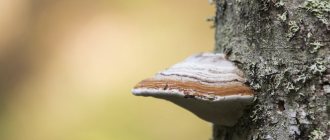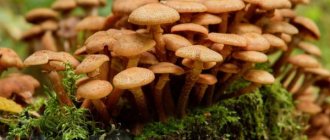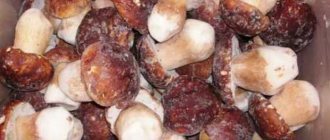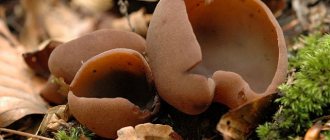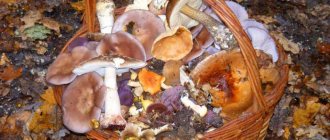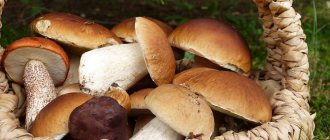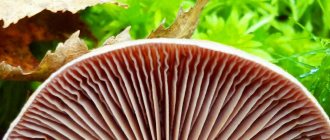Basidiomycetes lack differentiated germ cells. The fusion of nuclei (+ and -) occurs in one germ cell - the basidium. After the nuclei fuse, they divide twice, forming four daughter nuclei. On the surface of the basidium, outgrowths (sterigmata) grow, where these nuclei move, and sexual spores form around them. After the hyphae grow through the anastomoses, the nuclei of different sexes come together. Asexual sporulation in basidiomycetes is less common than in marsupials and, as a rule, does not last long. The taxonomy of basidiomycetes is based on the structure of basidia (simple or complex), their location, the presence and structure of fruiting bodies, the structure of the fertile layer (hymenium) and other characteristics.
Heterobasidiomycetidae/phragmobasidialae
Basidiomycetes with basidia separated by transverse or longitudinal septa. The fruiting bodies are tortuous and gelatinous on top, which is why they are called “tremulous”. At low air humidity they dry out, turning into thin crusts. Representatives of this subclass are mainly saprotrophs, rarely secondary parasites.
Exidia glandulosa settles on dying tissues of stumps, contributing to the drying out of the shoots (blockage of the shoots). Basidia with transverse septa, asexual sporulation.
Order exobasidial (Exubasidiales)
The mycelium is found inside the affected plant organs. The basidia developing on it reach the surface of the tissue. Fungi cause deformation of leaves and other organs of berry bushes in forest communities.
Exobasidium vaccini is the causative agent of deformation (exobasidiosis) of leaves, stems and flowers of lingonberry. The affected organs enlarge, take on a red color, and a white dense layer develops on the surface - basidium with basidiospores, which can separate conidia. The disease affects plants in good and satisfactory condition, which leads to the formation of stable foci of infection.
Description
Basidial fungi have the usual underdeveloped haploid mycelium, which appears during basidiospore germination, as well as a secondary diploid mycelium, which is well developed. The main organ of the fungi in question is the basidia. It develops from a binuclear cell. A sequential stage occurs - the division of the nucleus, which is divided twice.
These representatives of the class of higher fungi have special reproductive organs - basidia, among them there are representatives of thirty thousand species. A mature basidium has four basidiospores, which are located on the sterigmata. When they grow, a haploid mycelium appears. Then the mycelium merges, fruiting bodies develop on one of them, and then meiosis begins in the basidia. It ends with the formation of four nuclei, which develop into basidiospores.
Group of orders aphyllophoroid hymenomycetes
In representatives of this group, the basidia are located on the surface of the fruiting bodies in the form of a dense polysadial layer (hymenophore). The fruiting bodies are large, varied in shape - from prostrate cobwebby to dense cantilever-shaped (sometimes with stem buds), annual or perennial. The hymenophore can be smooth, folded, tuberculate, spinous, tubular, labyrinthine. The main representatives of this group are as follows.
Phlebiopsis gigantea (giant phlebia) is characterized by a filmy, loose fruiting body up to 50 cm long. Often located on trunks under the bark of dead trees and stumps. Weak wood destroyer (sub-destructor). The hymenophore is smooth, the mycelium forms branched cords. The wood becomes brown in color.
Telephora terrestris causes suffocation of seedlings in nurseries. Found in forests during adolescence. The fruiting body is leathery, dark brown, envelops the stem of the plant, causing it to weaken. It uses the plant as a mechanical support; the mycelium does not penetrate into the plant tissues. In nurseries, agricultural techniques are used to prevent the appearance and spread of the fungus.
Coniophora puteana (membranous house fungus) destroys wood in buildings and structures. It is widespread. The fruiting bodies are prostrate, fleshy, yellow-brown in color. Darkening over time. Forms thin films and cords. The rot is brown and fissured.
Serpula lacrymans (true house mushroom) is the most dangerous causative agent of rot in enclosed spaces, as it is able to use moisture obtained from the decomposition of wood. Control measures: prevention (impregnation of wood with antiseptics), replacement of affected parts and structures.
Typhula graminearum is the causative agent of seedling damping off (along with the marsupial fungus Sclerotinia graminearum). In the spring, after the snow melts, cobwebby, quickly disappearing mycelium and small dark sclerotia appear on the plants. In autumn, club-shaped, cartilaginous fruiting bodies form on the sclerotia. Control measures: compliance with phytosanitary and agricultural technology requirements.
Climacodon septentrionalis (northern hedgehog) causes white bladed heart rot of hardwoods. The fruiting bodies are annual, in the form of flat caps, collected in imbricated groups. The upper surface of the caps is white, hairy, later turning black. The hymenophore is represented by long thin yellow spines. The fungus affects old trees (oak, maple, linden, birch, etc.) in gardens and parks.
Tinder mushrooms
A group of fungi that form large fruiting bodies, mainly on woody plants and detritus, are often referred to in the literature as tinder fungi.
Laetiporus sulphureus (sulfur-yellow polypore) is the causative agent of red-brown prismatic rot. The fungus affects oak, poplar, linden, alder, ash, maple, larch and other species. Forms light suede films of mycelium in the cracks of the trunk. The fruiting bodies are annual, in the form of large imbricated groups of sulfur-yellow caps on a common base. At first soft and fleshy. Hymenophore tubular.
Inonotus obliquus (mown tinder fungus) is the cause of yellow-white corrosion-destructive rot of birch and other deciduous trees (alder, rowan). Large perennial growths (stroma) with a black fissured crust and woody rusty-brown tissue (“chaga”, “kyar”, “pakkula”) form on the trunks of affected trees. The fruiting bodies of the fungus develop under the bark after the tree dies. Annual, thin, prostrate, with a tubular hymenophore, brown, quickly destroyed.
Phellinus igniarius (false polypore) is the causative agent of white striped heart rot of deciduous trees. According to the characteristic features, basidiomas are divided into several forms - alder, birch, willow, etc. The fruiting bodies are perennial, solitary, cantilever-shaped, the surface is dark gray, sometimes black with concentric grooves and radial cracks. The tissue is brown, woody, hymenophore with small pores. Basidiomas persist up to 50 years of age and can reach large sizes. Characteristic signs of rot are the presence of black lines and a peripheral wound core up to 1 cm wide.
Phellinus tremulae (aspen polypore) causes white striped heart rot. Found only on aspen. The fruiting bodies are perennial, cantilever-shaped, flattened, can be prostrate on the branches, dark gray, with concentric grooves. Hymenophore tubular. By the age of 90 years, the damage to aspen usually reaches 80-90%, which creates problems during its operation. A search is underway for forms of aspen that are resistant to the disease.
Oxyporus populinus (maple polypore) causes yellowish-white leafy heart rot of maple and, less commonly, other deciduous species. The fruiting bodies consist of imbricated groups on one base, the surface of the caps is white or yellowish, often covered with a layer of moss. Basidioma tissue is white or light yellow, woody.
Ganoderma lipsiense (flat tinder fungus) settles in the butt part of trunks of deciduous trees (birch, aspen, oak, poplar, beech, willows, etc.), less often - coniferous ones, causing white core-sapwood butt rot in drying trees. Fruiting bodies grow in the lower part of the trunk in the form of flat woody-corky caps. Their upper side is uneven, wavy, with a furrowed thin crust, often brown-chocolate in color. The hymenophore is layered and tubular.
Fomes fomentarius (true tinder fungus) settles on weakened trees, destroys dead trees and stumps, white rot, marble rot, heartwood-sapwood rot. The fruiting bodies are perennial, cantilever-shaped, often gray, darkening, with concentric stripes. The fabric is soft, reddish-brown. Hymenophore tubular, layered. Affects deciduous trees: birch, aspen, linden, ash, etc.
Piptoporus betulinus (birch polypore) causes yellowish-brown lamellar heartwood-sapwood rot of dying birch trees, dead wood, stumps and dead wood. Basidiomas are annual, in the form of round or flat caps, attached sideways to the substrate, smooth, with thin skin of light brown color. Hymenophore tubular.
Daedalea quercina (oak sponge) is the causative agent of dark brown fissured butt heart rot of oak, beech and other deciduous trees. It affects stumps and the butt part of the trunk. The fruiting bodies are perennial, in the form of flat, one-sided caps, cantilever-shaped, sometimes in groups. The hymenophore is labyrinthine.
Fomitopsis officinalis (larch sponge) most often affects larch, as well as pine, cedar, and fir. Brown heartwood prismatic rot. Basidiomas are perennial (up to 80 years and older), oblong-cylindrical, cantilever-shaped, yellowish or off-white, with white loose tissue. Hymenophore tubular. In Eastern Siberia, the prevalence of larches by the age of 100-120 years is 12-21%.
Phellinus pini (pine sponge) is found on pine and other conifers, causing variegated heart rot. The fruiting bodies are perennial, in the form of lateral caps or cantilever-shaped bodies, brownish or dark brown, with concentric grooves and radial cracks. The tissue of the fruiting bodies is woody, hard, rusty brown. The hymenophore is tubular, the tubes are angular. The infestation of pine increases with age and recreational load. The maximum growth of infected trees occurs at the age of 120-130 years.
Phellinus chrysoloma is the cause of variegated heart rot of spruce. It also affects pine, larch, and fir. The fruit bodies are flat, semi-prostrate, brown, darkening, with concentric grooves and radial cracks. Hymenofortubular, tubes angular.
Fomitopsis pinicola (bordered polypore) causes brown heartwood-sapwood prismatic rot of coniferous and deciduous species. In the last stage of decomposition, the wood breaks down into prismatic pieces, turning into a powdery mass. The fruiting bodies reach large sizes, are perennial, cantilever-shaped, sometimes flattened, often dark in color. The edge of the fruit body is rounded, red or orange in color. The tissue is light yellow, woody, the hymenophore is tubular. A typical detritus destroyer (“forest orderly”), sometimes found on drying out and severely damaged trees.
Gloeophyllumsepiarium (“fence” or “pillar” mushroom) is a typical destroyer of wooden structures, sleepers, and posts. The fungus causes brown fissured rot. The fruiting bodies look like thin leathery one-sided caps, furrowed on top, hairy, dark brown in color. The hymenophore of basidiomas consists of yellow-brown sinuous plates, sometimes fused.
Heterobasidion annosum (root sponge) causes variegated pitting-fibrous rot of the roots and butt part of the trunks of pine trees and other species. The main harmful disease of pine in artificially created stands. Fruiting bodies are formed at the root collar and on the roots, prostrate, with curved edges, perennial. The hymenophore is located on top of the basidiomes, tubular. The damage to plantings is focal, the roots are saturated with resin, take on a reddish color, become “glassy”, with a turpentine odor. Tree crowns thin out, needles turn yellow and dry out. Stem pests settle on drying trees. A system of measures to combat the disease has been developed depending on the age of the tree stand and the degree of its infestation.
Phaeolus schweinitzii (Schweinitz polypore, felt-brown polypore) causes the development of brown fissured root and butt rot of coniferous and deciduous species. Often found on larch, pine, oak. The fruiting bodies are annual, appearing in mid-summer, often on the roots, less often on tree trunks. By autumn, they are funnel-shaped on the roots, with stem rudiments, or in the form of a cap with a diameter of up to 0.5 m. The tissue of the fruiting body is felt, fibrous, brownish-rusty in color. The hymenophore is located below, tubular. A characteristic disease of mature and overmature green spaces.
Irpex lacteus is the causative agent of white rot of yellow acacia wood.
Phellinus ribis causes white central rot in a number of shrubs (hawthorn, euonymus, currant, etc.).
Phellinus laevigatus causes light yellow rot of buckthorn trunks and shoots.
Where are they used?
Not only edible, but also inedible and poisonous basidiomycetes are actively used. Dangerous substances and poisons are formed in the fruiting body of the latter. The heaviest is muscarine. There is a lot of it in fly agaric, satanic mushroom, and toadstool. The class of poisonous representatives consists of twenty thousand species - micromycetes and macromycetes.
Edible mushrooms are those that do not contain any harmful substances that are unpleasant to the taste. They can be distinguished by their characteristic pleasant mushroom aroma. Many are edible even raw. Some edible mushrooms have a not very pleasant smell and taste bitter. In this case, special processing is required (soaking, cooking, drying, salting). For example, morels and russula are boiled for five minutes. The honey fungus also requires processing.
Inedible mushrooms include mushrooms that have a distinct unpleasant odor, bitter taste, and contain harmful substances. In this case, the bad components cannot be destroyed by any heat treatment. Inedible mushrooms are used as a seasoning (very rarely!), and also for medicinal purposes.
Another class is the poisonous basidiomycetes. They contain toxic substances in their bodies that are dangerous to human health and life. There are three groups of poisons. The first representatives include local action mushrooms (spring honey mushrooms, false puffball, bitter russula). They are insidious in that they have a detrimental effect on the gastrointestinal tract and immune system. Fatalities from such a shipment are rare.
The second group of poisonous mushrooms affects the human central nervous system. They are also called hallucinogenic. Representatives include hebelomas, vomiting russula, fly agarics, and entolomas.
The third group is the most difficult. Mushrooms, if eaten, destroy the body with toxic substances. A person, even for several days, may not suspect that he has been poisoned, while the organ cells are already disintegrating. Representatives of poisonous basidiomycetes include toadstool, spring fly agaric, spider web and others.
Group of orders Agaricoid Hymenomycetes
The mushrooms included in this group have short-lived fruiting bodies that quickly decompose. They consist of a cap and a stem, often a central one. The tissue of basidiomas is fleshy, sometimes cartilaginous or leathery. The hymenophore is lamellar or tubular, easily separated from the tissue of the fruiting body. These fungi act in the forest as mycorrhiza-formers, soil and litter saprotrophs, and less often as causative agents of rot of the roots or trunks of growing trees. Basidiomas of many species are edible and serve as a by-product of forest use. Among the representatives of agaricoid fungi, the following species are of phytopathological significance.
Armillaria mellea (autumn honey fungus) causes white sapwood rot of the roots and butt of the trunk of coniferous and deciduous trees. Autumn honey fungus is characterized by the formation on the roots and lower part of the trunk of white fan-shaped mycelium, rhizomorphs and groups of fruiting bodies, which consist of a cap on a central stalk. Hymenophore lamellar. At the beginning of development, the caps are covered with a thin film (volva), which then breaks. Its remains are preserved on the cap and in the form of a ring on the stem.
Pholiota adiposa (fat flake) is the cause of brown pitted heart rot of coniferous and deciduous species. Basidiomas have the appearance of a round scaly cap with a diameter of up to 15 cm on a scaly stalk with a volva ring. The hymenophore consists of radial plates, initially yellow, then brownish-brown.
Paxillus panuoides (mine, or lamellar, house fungus) causes brown cracked rot of softwood in residential buildings and other wooden buildings, underground structures and mines. The fruit bodies are fleshy, round or elongated, with a short lateral stalk or without a stalk, solitary or collected in groups. The hymenophore plates are radially diverging, branching, initially light, then egg-yellow and brownish.
Measures to combat wood rot:
- stem rot of growing trees - phytosanitary felling;
- forestry measures, in green plantings - treatment;
- root rot - creation of sustainable tree stands, phytosanitary felling, removal of stumps, use of chemical and biological (for example, based on antagonistic fungi) preparations;
- rot of commercial wood - compliance with storage conditions, use of antiseptics; fluorine-containing waste from aluminum production can be used to protect wood materials.
Places of growth, beneficial properties
Basidial mushrooms are mostly considered edible. They grow mainly in forests (in the wild) and have delicious taste and nutritional properties. Edible basidiomycetes can be considered a complete nutritional product. What mushrooms belong to them?
- Boletus.
- Russula.
- White milk mushroom.
- Black milk mushroom.
- Champignon.
- White, or boletus.
- Honey mushrooms.
- Boletus and many others.
The porcini mushroom has forms and varieties that differ in morphological and environmental characteristics. The porcini mushroom grows in spruce groves. The fruit body with a brown cap has light and dark spots. In birch groves there is another variety - a white birch mushroom with a light and grayish cap. You can distinguish it by its thin and long stem.
The pine boletus mushroom grows in pine forests. It has a short, brownish-cherry stem. Accordingly, the oak mushroom grows in oak forests; its cap is grayish-brown in color. Higher mushrooms prefer sandy and clayey soils. These predominate in deciduous forests. For example, they include garlic. It is consumed both fresh and prepared, and is also used as a seasoning. The fruiting body of edible mushrooms contains many substances useful to humans. These are carbohydrates, fats, proteins.
Mushrooms contain vitamins such as A, B, C, D, PP. White ones contain a large amount of vitamin C. The honey fungus is also rich in beneficial microelements. It also has antibacterial properties.
Teliobasidiomycetes/Sclerobasidiomycetes (Teliobasidiomycctidae/Sclerobasidiomycetidae)
According to the system under consideration, teliomycetes include microscopic fungi that do not have fruiting bodies. Their basidia (telio- or sclerobasidia) grow from thick-walled cells (teliospores). Species included in this subclass are highly pathogenic, causing economically significant diseases of agricultural plants, forest and ornamental tree and shrub species and flower crops. All representatives of this class are obligate parasites with a narrow phylogenetic specialization. According to biological characteristics and types of diseases caused, they are divided into two orders.
Features
Basidiomycetes are multicellular organisms, so they are classified as higher. Their hyphae are separated by membranes. Based on the type of nutrition, like lower ones, fungi are divided into parasites and saprophytes. Among the parasitic fungi are tinder fungus and chaga. Both of these species are found on trees and are also used for medicinal purposes. The main distinguishing feature of basidiomycetes is the cap, stalk, method of reproduction and feeding; their mycelium consists of cellular hyphae; contain chitin. Externally, you can always recognize a mushroom that is complex in structure. There are about eight thousand species in the world of cap mushrooms. Some of them are used in cooking. Poisonous mushrooms are often used for medicinal purposes, some as narcotic and psychotropic substances.
Order smut (Ustilaginales)
The mycelium of smut fungi develops inside the tissues of affected plants. Deformation of the affected organs is often observed.
By the end of the development period, the mycelium of smut fungi breaks down into thick-walled dark-colored cells - chlamydospores. Any aboveground organs of plants are affected, which, as a result of pathogenesis, turn out to be filled with a mass of dark teliospores. It is an economically important disease of agricultural (mainly grains and oilseeds) and flower crops, as well as wild herbaceous plants.
Pucciniaceae family
Representatives of this family have separate teliospores, sometimes connected in chains, with a colorless stalk.
Puccinia graminis is the causative agent of stem (linear, black) rust of cereals (II-III-IV) and barberry leaf rust (0-I). Signs of the development of the disease are the formation of long pustules on the leaves of cereals. The pustules are initially orange-yellow in color, turning black by autumn (autumn sporulation). Spring sporulation - spermogonia and aetia are orange, cup-shaped, and develop on barberry leaves. Control measures in nurseries of ornamental crops: destruction of cereals, chemical protection.
Gymnosporangium juniperi is the causative agent of rust of junipers (II-III-IV) and rosaceae (0-I). On juniper, the disease causes swelling of the shoots; on other species, the leaves have red-orange spots with columnar aecia. Control measures: removal of plantings from intermediate hosts.
Phragmidium mucronatum causes rose rust (I-IV), a single-host parasite. Aecia are collected in groups, reddish-orange. With strong development, the leaves fall off prematurely and the shoots become deformed. Control measures: phytosanitary, chemical protection.

